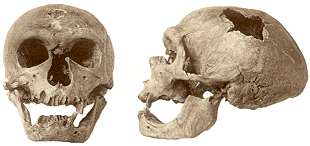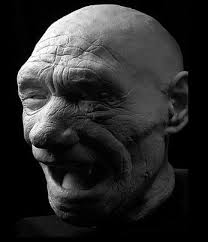In 1908 the skeleton of a Neanderthal was found in a small cave in La Chapelle-aux-Saints, France. Even though I said “skeleton” it was not a complete one. The bones that were found were the skull, the mandible, most of his vertebrae, a number of ribs, most of the long bones of the arms and legs (long bones include humerus, radius, ulna, femur, tibia, and fibula), along with several of the smaller bones of his hands and feet (carpals, metacarpals, and phalanges). With that said, what is the reason for the the name “The Old Man?” In the following blog I will discuss the state of his skull and how the finding of him changed the way we see Neanderthals.
Nowadays when you hear the term “old man,” what is the age you associate with it? A male around 70 and above is now what we would call an old man. This skeleton, was nowhere near the age we now see fit to be labled old man. The time of death for the Neanderthal male that was found is estimated to be between 25 – 40 years of age. The reason for naming this skeleton “The Old Man of La Chapelle” was because of the state of his skull and of his spine/bones.
This discovery was one of the reasons we at first saw Neanderthals as brutes because of his stance when standing. In 1913, the physcial anthropologist, Pierre Marcellin Boule, examined and restored the bones he was given. When he was done he could confidently deduce that the because of the iregularities of the spine that when the Old Man stood, he would be hunched-over. It was not til many years later that we can agree that his stance was most likely due to osteoarthritis, and the hunched-over stance was an isolated observation. But before they took a careful look at his vertebrae and stance, the thing that jumped out to make this Neanderthal an old man was when looking at the skull (image below, next to the skull is an interpretation of how he looked). Your immediate conclusion is “this belonged to an old man.” And just like with the spine, which we first came to an incorrect conclusion, with the skull, it presents an intimate look back to how the Neanderthals lived.
Nowadays when you hear the term “old man,” what is the age you associate with it? A male around 70 and above is now what we would call an old man. This skeleton, was nowhere near the age we now see fit to be labled old man. The time of death for the Neanderthal male that was found is estimated to be between 25 – 40 years of age. The reason for naming this skeleton “The Old Man of La Chapelle” was because of the state of his skull and of his spine/bones.
This discovery was one of the reasons we at first saw Neanderthals as brutes because of his stance when standing. In 1913, the physcial anthropologist, Pierre Marcellin Boule, examined and restored the bones he was given. When he was done he could confidently deduce that the because of the iregularities of the spine that when the Old Man stood, he would be hunched-over. It was not til many years later that we can agree that his stance was most likely due to osteoarthritis, and the hunched-over stance was an isolated observation. But before they took a careful look at his vertebrae and stance, the thing that jumped out to make this Neanderthal an old man was when looking at the skull (image below, next to the skull is an interpretation of how he looked). Your immediate conclusion is “this belonged to an old man.” And just like with the spine, which we first came to an incorrect conclusion, with the skull, it presents an intimate look back to how the Neanderthals lived.
Since he had no teeth, eating would be an uncomfortable, and possibly painful task. He did not die shortly after either, by evidence of bone growing over the empty sockets; he most likely lived 10 or so years after losing them. It was thought that someone in his tribe would have to process food for him. Some argue that he still had a few incisors, canines, and premolars, so he could effectively chew his own food. Given that is true, with his osteoarthritis, he had no way of getting around. “Scholars Dawson and Trinkaus (1995, 1997) argued that the osteoarthritis was evidence of trauma resulting from some heavy physical activity that occurred during his lifetime, incapacitating him.” I believe that the younger of his tribe would care for him, similar to the way we care for our elderly.
I find it so interesting how the way we age has changed throughout the ages, or perhaps, this was the regular aging cycle for Neanderthals. Even so, the aging of our evolutionary ancestors, even those in the early 1800s, are now completely different when compared to our aging cycle. But, as I said in an earlier blog (http://anthropologicalconcepts.weebly.com/blog/-getting-older) we all have to accept getting older as part of our life cycle. Here is a link in which you can look at the skull of the Old Man from different angles: http://efossils.org/page/boneviewer/Homo%20neanderthalensis/La%20Chapelle-aux-Saints.
Please feel free to comment on what you thought of the blog, or other physical anthropological subjects you would like me to cover.
I find it so interesting how the way we age has changed throughout the ages, or perhaps, this was the regular aging cycle for Neanderthals. Even so, the aging of our evolutionary ancestors, even those in the early 1800s, are now completely different when compared to our aging cycle. But, as I said in an earlier blog (http://anthropologicalconcepts.weebly.com/blog/-getting-older) we all have to accept getting older as part of our life cycle. Here is a link in which you can look at the skull of the Old Man from different angles: http://efossils.org/page/boneviewer/Homo%20neanderthalensis/La%20Chapelle-aux-Saints.
Please feel free to comment on what you thought of the blog, or other physical anthropological subjects you would like me to cover.


 RSS Feed
RSS Feed
